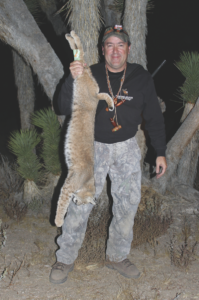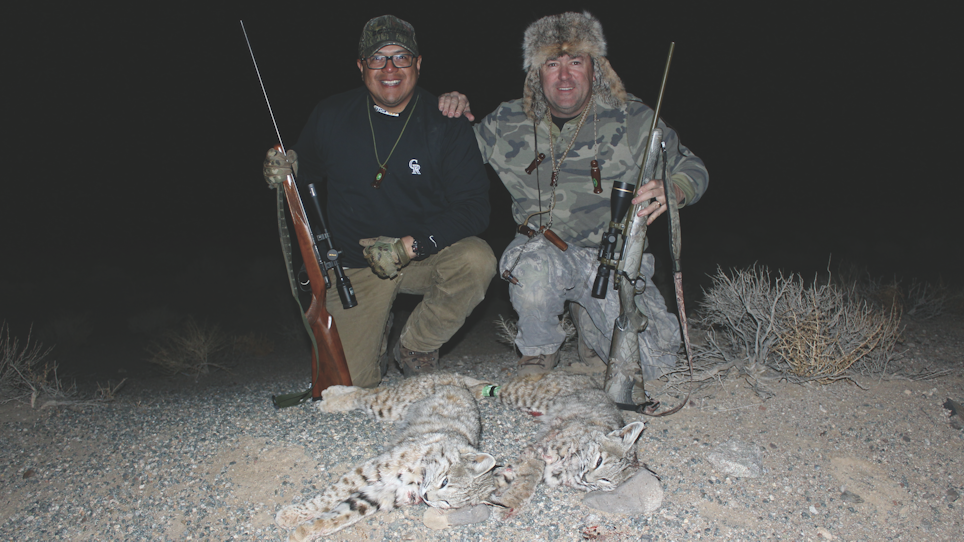Jose DeOrta (left) with his third bobcat and the author with my fifth after a successful season that came following years of extensive drought. Wildlife rebounded quickly, though, as it often does. (Photo: Tim E. Hovey)
The 2015-16 bobcat season ended with a whimper. For the previous 11 seasons I have hung at least one tag a year on the leg of a bobcat. With very few sightings and no shot opportunities, I had to eat all the bobcat tags I purchased in 2016.
My bobcat hunting streak was over.
As a hunter I was disappointed. As a biologist it’s exactly what I expected.
The Drought
Beginning in summer of 2011, California began to slip into an unprecedented drought. For almost five years, the southern portion of the state received below average annual rainfall amounts. Where I lived, I can remember it only raining twice in those five years. Water restrictions were handed out for everything from showering to watering your lawn.
As a hunter, the drought impacts to the wild world during that period were devastating to witness. The lack of water turned almost all the habitat brown and, as the dry years progressed, the response of the wildlife was easy to see. Upland birds, like quail completely disappeared. Canyons where their calls echoed throughout the year now sat silent.

The author filled his five tags after several years of tough hunting due to extensive drought in southern California. (Photo: Tim E. Hovey)
Small mammals like rabbits and squirrels were so infrequently encountered, we stopped hunting them. With a reduction of the forage species, naturally the predator numbers also began to decline.
Beginning in 2014, I started noticing a serious drop in coyote and bobcat numbers in all the areas we hunted. We had so many blank calling trips during that year, that we stopped hunting a month before the end of the season. The drought was definitely taking its toll on all levels of wildlife in the Golden State and hunters were the first to notice the changes.
Thankfully, in spring of 2016, after five long dry years, California received enough rain in four days to put an end to the drought. Within weeks of the lengthy downpour, the surrounding hills began to green up. Almost instantly, the wildlife began to respond.
Beginning in spring of 2017, for the first time in six years, we started seeing an abundance of quail. Small game also rebounded. Cottontail rabbits of all sizes were everywhere we hunted. The wild world seemed to explode once life-giving water returned to the landscape. And with the return of the prey, I knew the predators would follow.
Back on the Hunt
As I have the last dozen years, I headed out the evening before opening day of the 2017 bobcat season to start night hunting the early hours of the opener. Along on this trip was my good friend Jose De Orta. He and I have hunted together for more than a decade and in that time he had yet to kill a bobcat. This season, I was determined to change that.
Sure enough, in the early hours of the 2017 opener, I was able to put a beautiful bobcat in front of Jose and he did the rest. To punctuate the start of the season, on the next stand, I called in a second bobcat and I got to hang a tag on it — my first for the 2017 season.
The next day we took care of the cats and headed home. On the drive back, Jose and I discussed the trip. During the early morning calling session, we had called in four cats and killed two of them. I tried to remember the last time I had called in four cats during a single evening of calling. It had been awhile. With two cats in the back after our successful hunt, I was optimistic about what the rest of the season would hold.
A few days later I headed back out with my good buddy Ed Davis. Ed and I have been hunting together for over a dozen years now and we try and get out for at least one good night hunt during the season. Once he heard we had killed two cats on opening day, he wasted no time in planning a return trip.
By the time we pulled off into one of Ed’s favorite calling spots, it was pitch black. We had already called four empty night stands and it was getting late. We set up in the new area and started calling. As Ed shined the light, I could see the terrain. Large rocks and Joshua trees were scattered as far as I could see in the thick darkness. To me, this stand just screamed bobcat.
We were getting close to the end of the stand when Ed stopped the light at the base of a Joshua tree. “Right here!” he whispered. I moved over under the light and found the glowing eyes in the scope. One short series on the call from Ed and the bobcat stepped out at 90-yards. One shot from the AR-15 and the big tom fell. The cat was a large fluffy specimen, light in coloration, and ended up being the only animal we called in on that short trip.
With prior commitments, we headed back early the following day. On the drive back, we talked of past hunts and good times. With the 2017 bobcat season only four days old and my second cat in the cooler, the conversation eventually turned to my 2007 bobcat season.
That year, with the help of Ed and a few others, I was able to fill all five of my bobcat tags for the very first time. With the improved environmental conditions this season, we talked about repeating that feat. I did have a few more trips planned, but I had no plans of chasing three more cats. That would all change after the next trip.
A Bobcat Triple
In January, during the dark moon, I met up with Jose again and we headed out to call some new territory. We pulled off the main road, drove in another few miles and got our gear ready. Since we had both filled bobcat tags this season, we decided to alternate on the rifle.
On the third stand, I was on the rifle and doing the calling. Jose quietly got into the bed of the truck and did a safety swing of the light like we always do. Before I even started calling, he spotted a set of eyes up on a hillside. I got the animal in the scope and was fairly certain it was a cat, but he was out further than I was comfortable shooting at night.
After 10 minutes of calling, the bobcat up on the hill never moved. Through the scope I could barely see two eyes. This told me the cat was more than 400 yards away. Since we had focused all our attention on the lazy cat on the hill, I told Jose to do a quick scan around to make sure we weren’t getting snuck up on.
Jose hadn’t even made it a full circle with the light when he spotted eyes, and they were a lot closer. While we were distracted, a bobcat had snuck in behind us. The cat was sitting on a boulder about 150 yards away, just looking at us. I quietly moved over and positioned myself under the red beam. Jose kept him in the halo of the light and I dropped him with one shot from my Ruger .204.
Back at the truck, we took some photos and I tagged my third cat of the season. Since the cat on the hill had stayed put, Jose decided to take a light and walk him down. After a 25-minute hike, I heard a single shot and he returned a short time later with our second cat of the evening.
We were excited that just like our first trip at the beginning of the season we each had a bobcat in the cooler.
The rest of the evening was uneventful. We were leaving the canyon when we decided to make one last stand. I offered the rifle to Jose as we got ready, but he declined — a decision he would later regret.
About 12 minutes in, I was about to end the stand when Jose spotted a set of bouncing eyes coming in fast. I lined up with the light and found the animal in the scope. The target was out at 350 yards and running as fast as an animal could run. The way it was coming in and the brightness of the eyes told me it was a bobcat, and he wasn’t stopping.
Finally, at 60 yards the big cat cut between two boulders and paused briefly. That was all I needed. I put one round right behind the cat's shoulder. My second cat for the night and my fourth for the season was on the ground. The big tom weighed 26 pounds and was the largest cat I killed that season.
The following day we took care of the cats and headed home. Jose was fully aware that I only needed one more cat to fill all five of my tags and he made it very clear he wanted to be part of the effort. He essentially began scheduling our next trip on the way home.
Another Double
During the next dark moon phase and with only two weeks left in the bobcat season, Jose and I were once again headed out for a night hunt.
We pulled back into the same area and started calling. Jose had told me on the drive up that I was to stay on the rifle until I had bobcat number five on the ground. My hunting friends are the best.
After a few empty stands, Jose once again spotted eyes close. The bobcat had come in from behind and was watching us from a rock ledge out at about 140 yards. I moved over and got lined up with the light. I steadied the .204 and squeezed the trigger. My fifth bobcat of the 2017 season was on the ground. To cap off the incredible season, a few stands later, I called in another bobcat for Jose, his third of the season, and the third time we had doubled up on cats during our recent night hunts.
Despite my success, I was more grateful we were able to watch the entire ecosystem rebound from the lengthy drought. After years of seeing little in the way of animals small and large, the response of the wildlife to the spring rainfall was amazing to witness.
Of course, the predator hunter in me knew what an excess in small game meant for the coyote and bobcat population. However, the biologist in me was grateful that all levels of life, from the wildflowers to the mule deer, were back, thriving and healthy. I can’t wait for the 2018 season!






